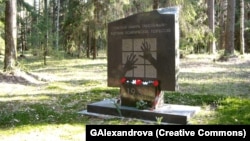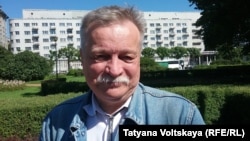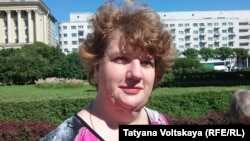ST. PETERSBURG -- At the Levashovo mass grave site outside Russia's northern capital, there are nearly two dozen separate memorials for various groups of victims of dictator Josef Stalin's Great Terror -- Assyrians, Belarusians, Jews, Italians, Lithuanians, Germans, and so on. Each one represents a small chapter in a historical crime that saw between 650,000 and 1.4 million people executed and millions of others imprisoned, deported, displaced, or orphaned.
One of the Levashovo stones features two hands reaching up from a prison cell toward the light, with the words: "To the eternal memory of the deaf-mute victims of political repression -- 1937."
That particular chapter of the horror story of the Great Terror began one night in August 1937 when members of the Leningrad Deaf-Mute Society were in rehearsal for a special production to be presented for the 20th anniversary of the October 1917 Bolshevik seizure of power. Two security agents in plain clothes unexpectedly entered the hall.
By the time the chapter closed, 35 deaf people had been summarily executed (34 of them sentenced to death on December 19, 1937, and shot in the back of the head on December 24) and 20 had been sentenced to 10 years in Stalin's labor camps.
Among the executed were scientists, artists, laureates of state productivity awards, athletes, teachers, and others. All of them -- according to investigators with Stalin's NKVD secret police -- were members of a pro-German fascist terrorist organization specializing in the distribution of fascist and counterrevolutionary literature.
"When I read the case files, I saw that [investigators] even forced the sign-language interpreters to lie so that they could write up falsified protocols," said Anatoly Razumov, a historian whose multivolume Leningrad Martyrology documents the Great Terror in the city of Leningrad, which is now St. Petersburg. "That's how the whole case was fabricated. And then the victims were shot."
The head of the Leningrad NKVD at the time was Leonid Zakovsky, who was himself executed in August 1938.
"Zakovsky used to say, 'Why are you whining about your sick and your crippled? In Leningrad, we just put them in the first category (i.e., sentenced to execution) and there is no problem. And in the camps, if someone is crippled or maimed, send him to be shot and that's it. No problem,'" Razumov told RFE/RL.
"This attitude partially explains the pitilessness of this case," he added.
Yulia Khoroshailova is a member of the All-Russia Society of the Deaf who first heard about the case in 1997.
"I was really surprised that such a case came up," she told RFE/RL. "Usually, we think that deaf people are always on the margins of events. After all, they can't hear so they don't know about much that is going on and many are not active members of society. So when I found out that the Great Terror didn't even pass us by, I was simply shocked."
If there is a hero in this story, it is David Ginzburgsky, a Leningrad factory worker and artist who turned himself into a historian to document the cases of deaf victims of Stalinism. He was able to interview two of the interpreters used during the interrogations and conducted groundbreaking archival work during the perestroika period. He died in 2004 at the age of 90.
Khoroshailova learned about the deaf-mute "fascist terrorist band" by attending a lecture given by Ginzburgsky.
"Later, we interviewed the descendants of the repressed, but they couldn't add much to what [Ginzburgsky] already knew because their families did not talk about these experiences," Khoroshailova said.
Ginzburgsky's research formed the core of the section on this case in Razumov's Leningrad Martyrology.
There is a very touching ceremony in one of the Levashovo meadows. They always invite me and, when I can make it, they insist every time that I tell them the entire tragic story and they listen to me with tears in their eyes."-- Historian Anatoly Razumov
In the 1930s, it was common practice for deaf people in Leningrad to make money by reselling postcards on commuter trains around the city. This fact became the key to the entire "plot" supposedly uncovered by the NKVD.
Under torture, the head of the city's society for the deaf, Erik Totmyanin, denounced several members of his group, accusing them of selling "counterrevolutionary materials." On the basis of his statements, five more people were arrested and tortured. Then six more. By this point, the case had reached into several factories considered crucial to the Soviet Union's defense capabilities. The accusations expanded to include sabotage, espionage, and the preparation of terrorist attacks against leading communists and members of the Soviet government.
The "gang" was also accused of distributing fascist literature provided by the German Consulate in Leningrad. (In 1937, Hitler's Germany and the Soviet Union had extremely tense relations; in August 1939, however, the two countries signed a nonaggression pact and became de facto allies in the division of Eastern Europe.)
As was typical of such NKVD cases, none of the incriminating postcards or "fascist literature" was included in the case files.
"Postcards had value back in the 1930s," Razumov said. "And everything that had value was taken by the NKVD officers."
On October 30 each year, people gather at the Levashovo mass grave site to mark the Day of Remembrance of the Victims of Political Repressions.
"To this day, there is a very touching ceremony in one of the Levashovo meadows," Razumov said. "They gather in a semicircle with an interpreter in the middle. They always invite me and, when I can make it, they insist every time that I tell them the entire tragic story and they listen to me with tears in their eyes."
At the entrance to Levashovo, there is a bell that visitors can ring in memory of the victims of Stalin who are buried there.
"In the visitors' book from 2003, there is a message that was left by the daughter of [Georgy] Zolotnitsky, who was shot there," Razumov said. "She came from Yekaterinburg and wrote: 'Papa, I came again. I am here. I am striking the bell. I know that you are deaf -- but you will hear me."
















